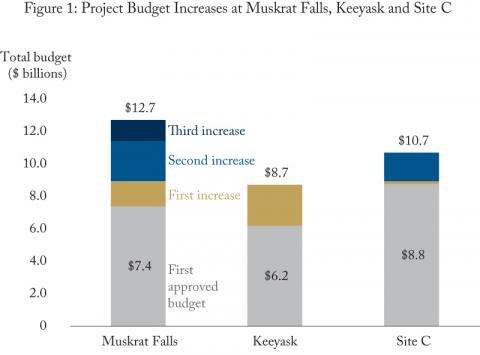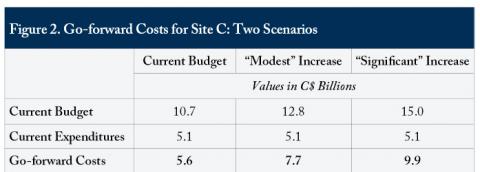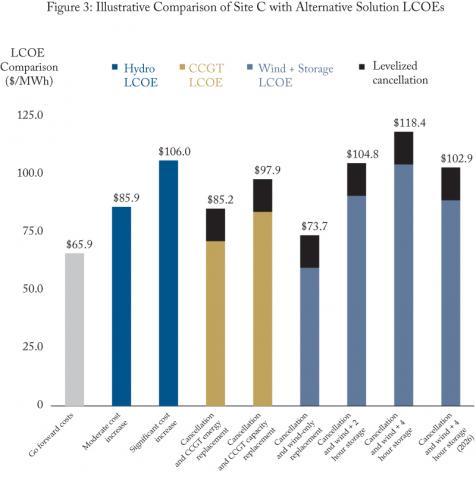From: A.J. Goulding and Mugwe Kiragu
To: British Columbia’s next government
Date: October 13, 2020
Re: The Case for Site C is Getting Weaker
In our C.D. Howe Institute Commentary, we assessed the cost-effectiveness of three marquee hydro projects under construction that stand out for their escalating budget estimates and schedule delays. The study demonstrated that the levelized costs from Site C, an 1,100 MW project on the Peace River in northern British Columbia, likely exceeded the costs of alternative carbon-cost adjusted combined cycled natural gas turbines (“CCGT”) as of January 2019.
Since then, Site C has faced multiple geotechnical and operational challenges. In a July 31, 2020 report to the BC Utilities Commission, BC Hydro classified the overall health of the project as “having serious concerns, specifically regarding schedule, scope and budget.” The project looks certain to miss its target completion date of 2024 and the scope of the geological risks – foundation enhancements needed to increase stability in the structure – suggest that a significant budget increase can be expected.
In this memo, we update the assumptions that underpinned the previous analysis. Even assuming a conservative estimate of budget increases, the economics still favour cancellation and replacement with an equivalent carbon-cost adjusted CCGT. Replacement with storage-backed wind capacity becomes more cost-competitive the longer the project is delayed.
At multiple stages of development, three megaprojects have faced cost overruns. Muskrat Falls in Labrador has had three major budget revisions and will be 72 percent over its original budget when commercial operations start this fall. Manitoba’s Keeyask and Site C have requested one major budget increase each of 41 percent and 20 percent, respectively (see Figure 1).
The literature on megaprojects suggests that these experiences are not uncommon. In a report to the Commission of Inquiry Respecting the Muskrat Falls Project, researchers assessed 274 hydroelectric dams worldwide and showed that the average cost overrun is 96 percent, with a median overrun of 32 percent. Their analysis (see page 11) showed that for Canadian projects, the average cost overrun is 41 percent. Therefore, Site C’s looming budget increase is not just expected, but also consistent with hydropower megaprojects both in Canada and around the world.
For this update, we adopted two scenarios of cost increases to the current budget: a “modest” incremental cost increase of 20 percent, and a “significant” increase of 40 percent, illustrated in Figure 2 below.
We then calculated the levelized cost of energy (“LCOE”) for the Site C project under each of the scenarios detailed above based solely on so-called “go-forward” costs. We compared these go-forward LCOEs to alternative approaches to meeting energy and capacity requirements in 2024, including levelized cancellation costs.
Site C project is marginally economic at current go-forward costs. In the “Modest” increase case, cancellation and replacement with carbon-adjusted CCGT is again economic. In the “Significant” case, the economics favour all alternatives, except for replacement with wind and a four-hour storage solution. However, this alternative becomes more economic once a two-year delay is considered. The results are illustrated below in Figure 3.
The updated results, augmented with a wind and storage case, demonstrate that Site C is marginally economic at current costs. Our analysis shows that any meaningful cost increase makes cancellation a better choice.
Furthermore, the more the Site C project is delayed, the lower potential future costs are for replacement with battery storage given current cost decline trends. As noted in our previous paper, there is value in optionality, which comes with the ability to build in smaller unit sizes spread out over longer periods of time. The case for cancellation further improves when considering the more granular nature of replacement technologies, which means the timing of investment can be tailored to better match future demand growth.
A.J. Goulding is President of London Economics International LLC. He has advised provincially owned hydro companies, IPP associations, and consumer groups. Mugwe Kiragu is a senior consultant at London Economics International LLC with wide ranging experience in modeling power system costs and analyzing regulatory accounts.
To send a comment or leave feedback, email us at blog@cdhowe.org.
The views expressed here are those of the authors. The C.D. Howe Institute does not take corporate positions on policy matters.
Sources: Authors’ calculations from BC Hydro; Manitoba Hydro; Nalcor
Source: Authors’ calculations from BC Hydro.
Sources: Authors’ calculations from BC Hydro; U.S. Energy Information Administration; National Renewable Energy Laboratory.








